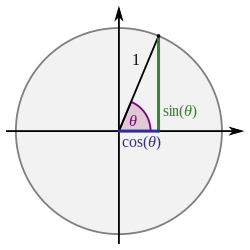
Back Driehoeksmeting Afrikaans Trigonometrie ALS ትሪጎኖሜትሪ Amharic Trigonometría AN त्रिकोणमिति ANP حساب المثلثات Arabic حساب المثلثات ARZ ত্ৰিকোণমিতি Assamese Trigonometría AST Triqonometriya Azerbaijani
| Trigonometry |
|---|
 |
| Reference |
| Laws and theorems |
| Calculus |
| Mathematicians |
Trigonometry (from Ancient Greek τρίγωνον (trígōnon) 'triangle' and μέτρον (métron) 'measure')[1] is a branch of mathematics concerned with relationships between angles and side lengths of triangles. In particular, the trigonometric functions relate the angles of a right triangle with ratios of its side lengths. The field emerged in the Hellenistic world during the 3rd century BC from applications of geometry to astronomical studies.[2] The Greeks focused on the calculation of chords, while mathematicians in India created the earliest-known tables of values for trigonometric ratios (also called trigonometric functions) such as sine.[3]
Throughout history, trigonometry has been applied in areas such as geodesy, surveying, celestial mechanics, and navigation.[4]
Trigonometry is known for its many identities. These trigonometric identities[5] are commonly used for rewriting trigonometrical expressions with the aim to simplify an expression, to find a more useful form of an expression, or to solve an equation.[6]
- ^ Harper, Douglas. "trigonometry". Online Etymology Dictionary. Retrieved 2022-03-18.
- ^ R. Nagel (ed.), Encyclopedia of Science, 2nd Ed., The Gale Group (2002)
- ^ Boyer (1991), p. [page needed].
- ^ Charles William Hackley (1853). A treatise on trigonometry, plane and spherical: with its application to navigation and surveying, nautical and practical astronomy and geodesy, with logarithmic, trigonometrical, and nautical tables. G. P. Putnam.
- ^ Mary Jane Sterling (24 February 2014). Trigonometry For Dummies. John Wiley & Sons. p. 185. ISBN 978-1-118-82741-3.
- ^ Ron Larson; Robert P. Hostetler (10 March 2006). Trigonometry. Cengage Learning. p. 230. ISBN 0-618-64332-X.